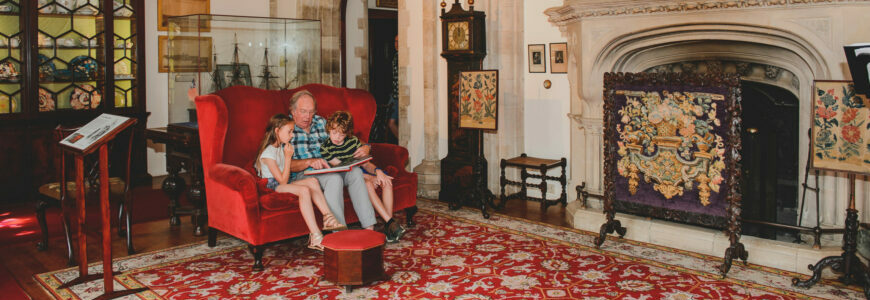
Discover over 800 years of history at Beaulieu. With a medieval abbey, a Victorian styled historic house, a WWII school for spies and much more besides, it’s the perfect historical day out.
NATIONAL MOTOR MUSEUM
Start your day in the National Motor Museum, the home of motoring history.
The entrance hall sets the scene for your journey around the museum, displaying an ‘Ages of Motoring’ timeline from the penny-farthing through to modern motors, but this is just the beginning of your trip through time…
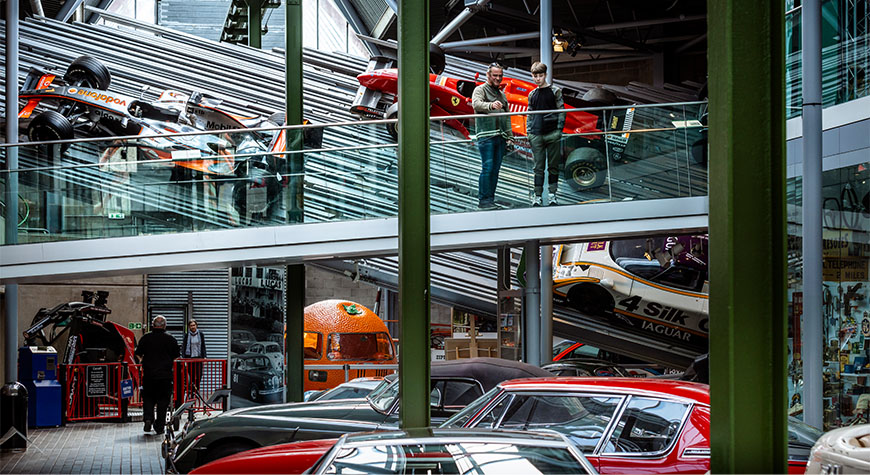
Turn left into Early Motoring to see the oldest vehicle in the museum (the 1875 Grenville Steam Carriage) and then progress through the museum’s many displays before finishing in Driving Change where we imagine the future of the motor car.
Highlights for history fans include:
- 1895 Knight. One of the first purpose-built petrol driven vehicles to run on public roads in Britain.
- 1903 Napier Gordon Bennett. One of the oldest British racing cars. Napiers were all painted green, which was then adopted as Britain’s racing colour.
- 1914 Ford Model T. Widely accepted as the car that brought motoring to the masses. Contrary to popular belief it was available in colours other than black!
- Bluebird CN7. A world-record breaker and the fastest vehicle in the museum at 403.10mph. Bluebird is part of our For Britain & For The Hell Of It display and can be seen alongside three other land speed record-breaking cars.
- 1938 Morris Eight. Features headlamp masks and white edged wings to meet WWII blackout regulations.
- 1961 Honda RC162. Ridden to victory by Mike Hailwood in the 1961 TT, this design made a significant impact on speed and reliability.
For a detailed guide through the museum, please visit the Car Lover Itinerary.
PALACE HOUSE
Follow the central path through the grounds until you reach Palace House, historic home of the Montagu family and a treasure trove for fans of Victorian history.

Explore the house at your leisure. Highlights include:
- Entrance Hall. See artefacts from three generations of the Montagu family who lived in Palace House. Don’t forget to look down – the carpet pattern is based on a floor tile from the Beaulieu Abbey ruins!
- The Portrait Gallery. Hung with pictures of Montagu ancestors, including Henry, 3rd Earl of Southampton, patron of William Shakespeare.
- Dining Hall. Once part of the monastic Great Gatehouse. The huge table that dominates the room originally stood in the servants’ hall at Ditton Park and is made from a single elm tree.
- Victorian Kitchen. See the working Victorian range, original bell board, and the menu board that is written up daily from the kitchen diary of 1889. Find out more about the restoration of the Victorian Kitchen.
- Edward, Lord Montagu’s Library. Includes a partners’ desk, designed for two people to work opposite one another, although with this desk one partner is more equal than the other as the drawers only open on one side!
- Upper Drawing Room & Ante Room. Peer up the ‘secret staircase’, admire the heraldic designs on the stained glass windows, and see if you can guess what’s unusual about the fireplace in the Ante Room.* Among the notable items in these rooms, you’ll find a set of Jacobean chairs, a 17th century Italian ebony and ivory cabinet and a Louis XV bracket clock.
You may be interested in: Palace House: One of the first public historic houses | Shakespeare’s Beaulieu
LUNCH
Catch the Veteran Bus back to the Brabazon Restaurant for lunch, where you can choose from a range of hot and cold food, sourced where possible from the Beaulieu Gardens.
Alternatively find one of the many picnic benches in the parkland to enjoy your lunch in the sunshine.
Did you know? The replica 1912 London bus made a star appearance in 1978 film The Thirty Nine Steps and featured in 1975 period drama Love Among the Ruins.

GARDENS
Walk off your lunch with a peaceful walk through the Beaulieu gardens.
Behind Monorail North Station you’ll find an entrance to the Mill Pond Walk. Follow the winding path between the trees to find the Rufus Memorial Cairn. Made using stone from the Beaulieu Abbey ruins, the cairn commemorates the death of King William Rufus who was killed on 2 August 1100 while hunting in the New Forest.
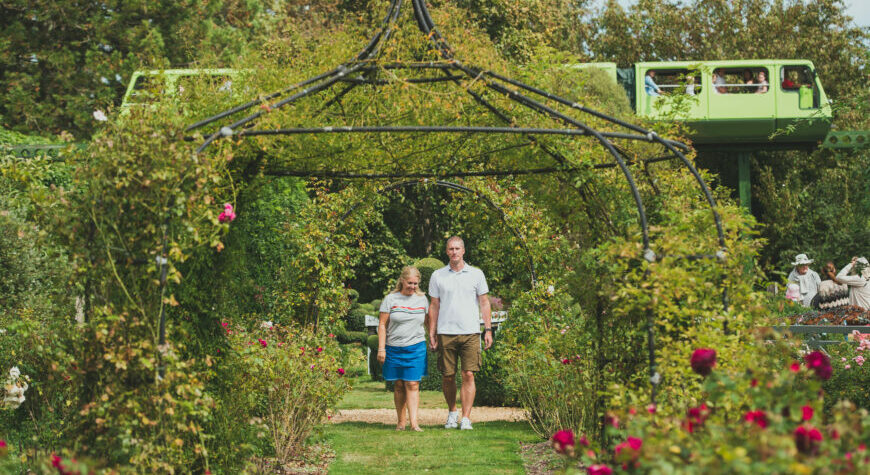
Next, make your way to the Victorian Kitchen Garden to discover what fruit and vegetables the gardeners are growing. The garden has been restored to its 1872 layout and the vine house is home to a dessert grape which has been producing fruit for over 100 years!
Cross over the central path to the Victorian Flower Garden, where you’ll find a Mad Hatter’s tea party-themed topiary display. It’s a little-known fact that Alice Liddell (the real ‘Alice’ in Lewis Carroll’s Alice’s Adventures in Wonderland) visited Palace House for a tea party in 1887 to celebrate the coming of age of the Hon. John Douglas-Scott-Montagu, later 2nd Baron Montagu of Beaulieu.
LITTLE BEAULIEU
Accompanied by young history enthusiasts? Continue up the central path until you spot the soaring wooden turrets of our adventure playground, Little Beaulieu, which is inspired by the history of the site.
From the charming towers and entrances that reflect Palace House to the stunning arches of the Beaulieu Abbey ruins, keep an eye out for architectural features you’ve seen around the site while the kids let off steam.
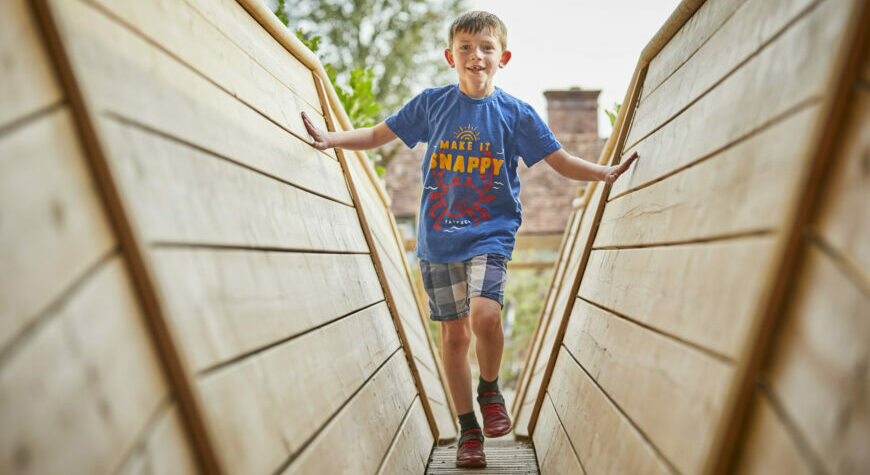
BEAULIEU ABBEY
Next on your journey, head to the medieval Beaulieu Abbey.
Founded in 1204, the abbey flourished under the Cistercian Order for approximately three centuries before being destroyed on the orders of King Henry VIII in 1538. Now the conserved ruins are an oasis of calm and home to an exhibition on monastic life.
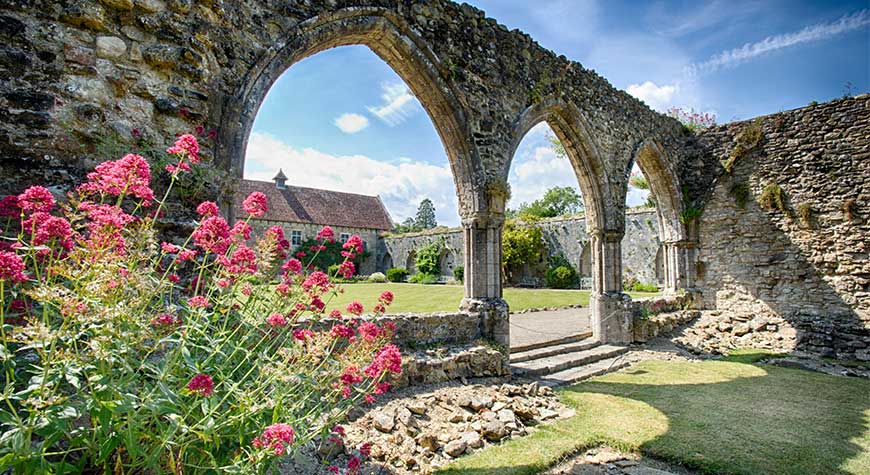
Highlights include:
- Abbey ruins. The Abbey Church was once the largest Cistercian building in England. Now the ghostly outlines of the preserved foundations provide an impression of the vast scale of what once stood here.
- The Cloister. Take a moment to pause and reflect here, where monks once studied, read or sat in contemplation. Inhale the aromas from the herb garden, planted with herbs used by the monks in medicine and cooking. If you visit over the summer holidays, you may also see falconry displays here.
- Beaulieu Parish Church. Originally the Choir Monks’ Refectory, this was one of only four monastic buildings to survive. The stained glass is mainly Victorian but the lancet windows are probably unchanged since monastic times and parts of the lectern on the west wall date from the 13th century. Visitors are welcome to enter when services aren’t taking place.
- The Domus and Monastic Life Exhibition. Another surviving building, the Domus was once the living quarters of the lay brothers. Downstairs you’ll find an exhibition which tells the story of the abbey and the monks who lived here. On the upper floor (which is occasionally closed for weddings and functions) you’ll find a series of embroideries depicting the history of the Abbey.
- Abbot’s Mews Exhibition. Learn about the monarchs and noblemen who practiced falconry. King James I was a keen falconer and hunting with birds of prey was a key part of his nine visits to Beaulieu.
SECRET ARMY EXHIBITION
As you leave Beaulieu Abbey, follow the path towards Palace House to find the Secret Army Exhibition.
Beaulieu was the wartime finishing school for the Special Operations Executive during World War II, and over 3000 agents trained here before undertaking missions behind enemy lines. Discover their stories, find out what they learned, and see artefacts that shine a light on these brave individuals.
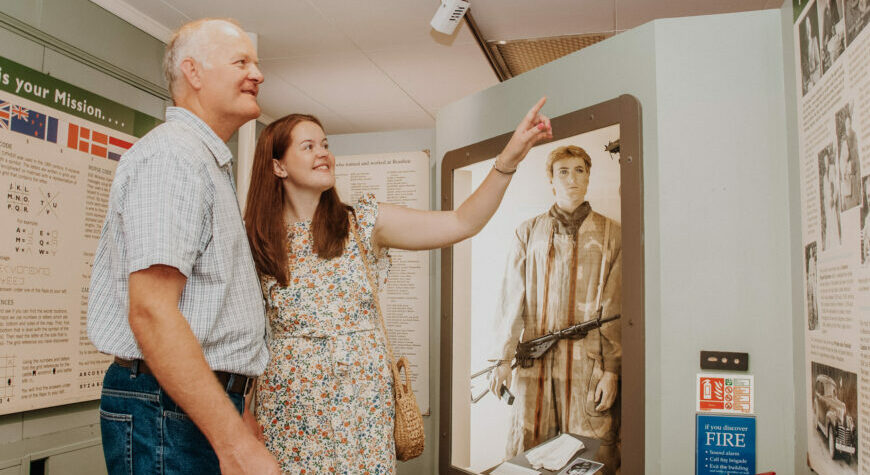
MONORAIL & COFFEE BREAK
From the Secret Army Exhibition, follow the central path to the Monorail south station and hop aboard to rest your feet and enjoy an aerial view of the grounds.
Leave the Monorail at north station and walk across to the Brabazon Restaurant to enjoy coffee and cake.

ON SCREEN CARS
Round off your visit with some modern history!
Head into On Screen Cars to see favourites from film and TV. Mr Bean’s Mini and Del Boy’s Reliant Regal are just some of the well-known vehicles you can see.
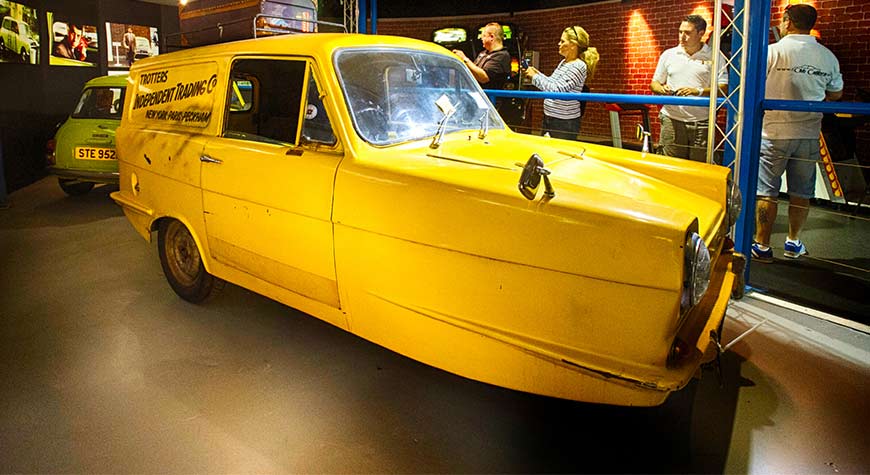
DEPARTURE
Before you leave, make sure you admire the tree-top griffin outside the visitor reception building, which was chosen because a griffin supports the Montagu family coat of arms.
Don’t forget to visit the gift shop to browse the range of specialist books and DVDs, which delve into the history of the Montagu family and the story of motoring.
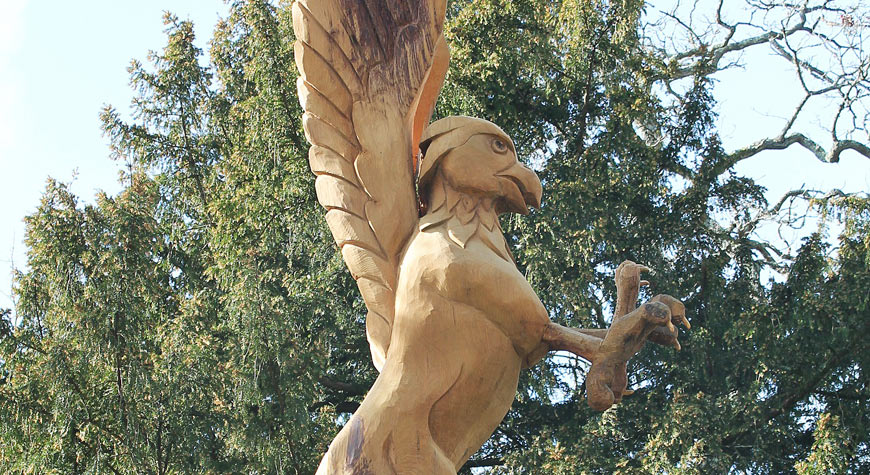
* Stuck? The fireplace in the Ante Room is unusual because it’s situated immediately below a window. Instead of having a central chimneypiece, the smoke is dispersed through flues on each side of the window.
This itinerary is for guidance only. We reserve the right to amend timings without warning as circumstances dictate. Vehicles and exhibits are occasionally removed from display for maintenance, so if you’d like to see something particular please check with us before you visit.
Due to the historic nature of our buildings, some areas of the attraction are unsuitable for wheelchair users. Please see our accessibility page for more details. Our team will be happy to advise on alternative viewing or access points as appropriate.
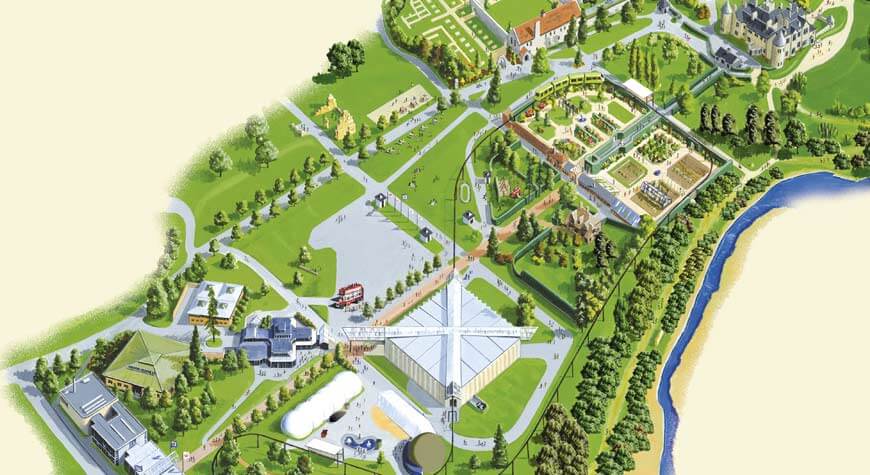
INTERACTIVE MAP
Plan your visit with our interactive map of the Beaulieu complex.
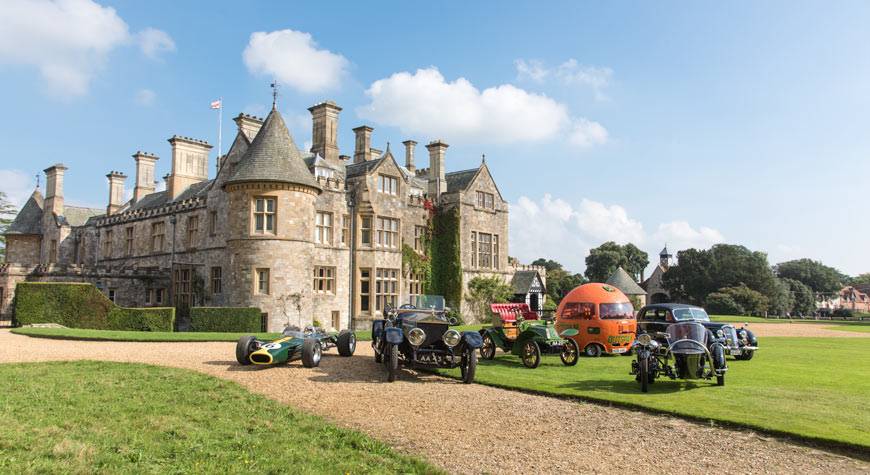
Tickets & Information
Your admission ticket includes entry to all the Beaulieu attractions, including The National Motor Museum, Palace House, Beaulieu Abbey and more.
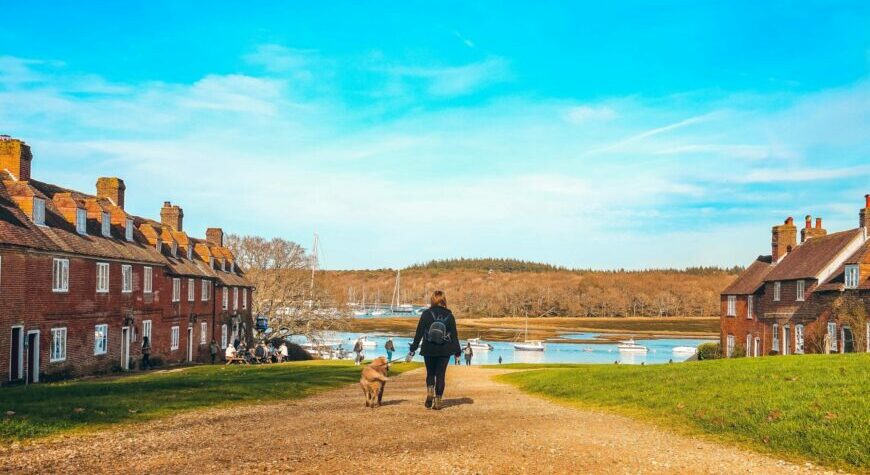
Visit Buckler’s Hard
Visit our sister attraction, Buckler’s Hard, to explore the 18th century village where ships for Nelson’s Navy were built.
